We were keen to see something of the rainforests of the east of Madagascar so on 1
st October 2024 we set out from Sambava for Marojejy where the forest clings on around an impressive hunk of granite over 2000 metres high. It has been a national park since 1998.
As well as Mika, our own guide, we acquired a local minder called – appropriately as it turned out – Donation. He wore a red baseball cap and, at the Park visitor centre, supervised what appeared to be a Great Expedition into the forest. We drove on to the village of Mandena where we met our cook, a ‘trainee guide’ Stanislas and the five porters who would carry our luggage and necessary supplies to two ‘camps’ within the reserve.
The atmosphere was hot and steamy but the first part of our walk was a pleasant stroll between ricefields. People also cultivated vanilla, although because the best vanilla is a Mexican species there are no local pollinators so humans have to tenderly fulfil this role. Narrow footpaths took us into secondary forest and Stanislas showed us a chamaeleon then we were into rich primary forest with tree ferns, stands of huge buttressed trees, and enormous palms towering above most of the rest of the forest. Spectacularly big screw pines, like something out of an alien movie, with armoured leaf edges that could have doubled as chain-saws threatened to sever any carelessly placed hands. There were superb giant red and black millipedes snaking across the leaf-litter or climbing tree trunks, and innumerable deep emerald green pill millepedes, that quickly rolled up as any hedgehog might for protection.
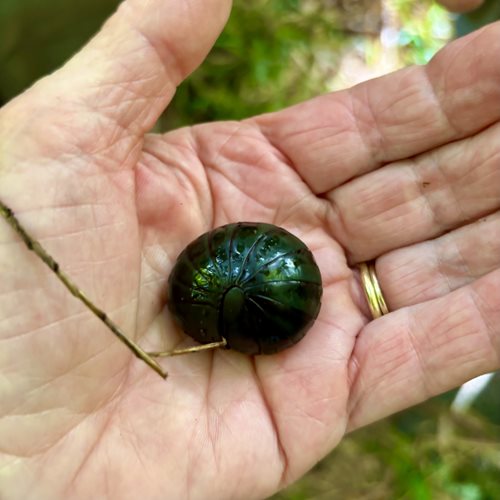 |
| The giant Emerald Pill Millipede, Zoosphaerium neptunus |
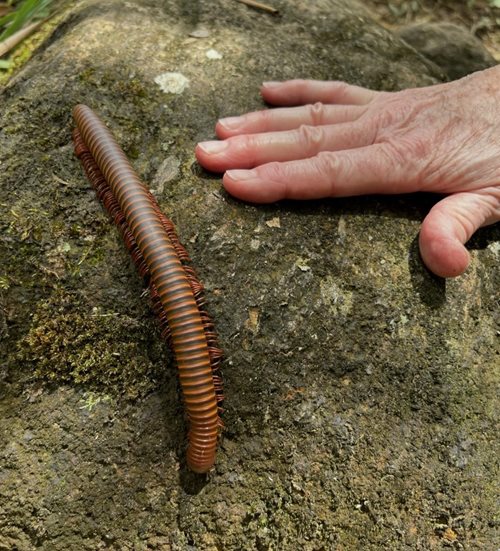 |
| A magnificent millipede |
 |
| Tree ferns |
As the terrain steepened and we began the ascent in earnest, the path became more slippery and treacherous with lots of roots to trip over. The rather over-attentive Donation, still wearing his red baseball cap, walked half a step ahead, saying
‘Mora mora,’ (slowly-slowly) a lot, not realising that it is good when hill-walking to find one’s own steady pace. We were such a large noisy party too that we saw little signs of wildlife except tiny green-backed and other tree-frogs and the occasional swishing sound as lemurs leapt away from us. Then, clocking our interest, Stanislas showed us amazingly well camouflaged geckoes, snakes and a stump-tailed chamaeleon barely 7cm long. It was the colour of a dead leaf, and had a spiny back and horns over his eyes which might have given a hungry bird a sore mouth.
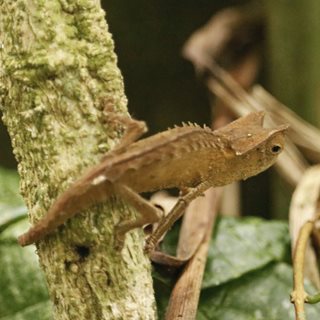 |
| A diminutive Stump-tailed Chamaeleon with its spiky back and 'horns' |
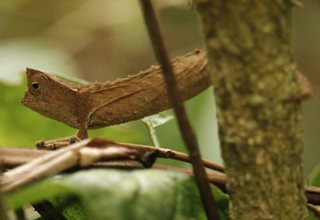 |
| Stump-tailed or Leaf Chamaeleons have perfectly functional prehensile tails |
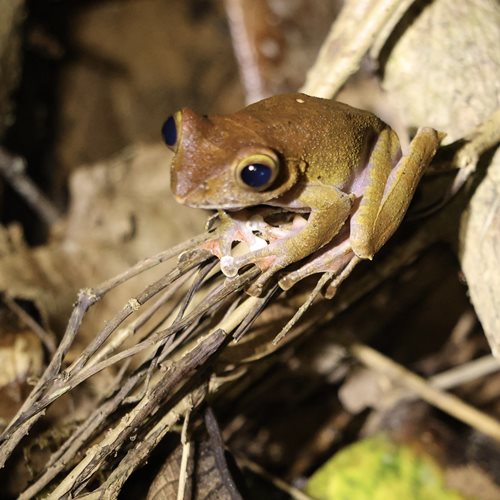 |
| The forest was hopping with tree frogs - photo by Simon Howarth |
The weird thing about moving through dense forest is how difficult it is to keep track of how far you’ve walked and how far there is to go. As the sweat streams and fatigue sets in, it is easy to settle down into automatic pilot and just put one foot in front of another, on and on, starting not to care and certainly not looking very enthusistically for wildlife.
We came to a fork in the path where Donation indicated we should take the downhill option. I wasn't keen, knowing we’d need to climb up again, but this took us to a small waterfall with a large pool at the bottom, and soon we’d stripped down to underwear and were in enjoying the most glorious and refreshing of wild swims.
But we had more ground to cover, rejoined the main path and headed on up. We entered a bamboo thicket were Stanislas was pointing. Although he was only a guide-in-training, he was sharp-eyed and proved to be an excellent spotter. We were surrounded by a troop of fluffy-looking bamboo lemurs. They carried on doing what bamboo lemurs do – eating bamboo – while I failed to manoeuvre myself into a spot where I could manage a clear shot – with my 400mm telephoto lens. My arms soon fatigued from holding the heavy camera equipment and I walked on wondering how much further we’d have to walk.
Then suddenly I was hit with the realisation that we had arrived, in a small clearing. There was a walless corrugated iron shelter in which there were tables, bench seats and a kitchen area where several men were busy. This was Mantella, Camp One, at an altitude of around 450 metres and about six kilometres from Mandena; it had seemed further. The porters had piled our bags in a heap and were sitting around chatting. Mika, our in-country guide had gone on ahead while we were watching bamboo lemurs and greeted us with a grin and glasses of an unattractive-looking cloudy slightly greenish liquid. We inspected the welcome drinks. They contained a lot of vegetable detritus. ‘What is it?’
‘Rhum! And I added fresh ginger to make it extra tasty?’
I poked my nose into the glass. It certainly smelled of ginger. Then a slurp gave me a kick like a donkey’s. I couldn’t decide if it was the rum or the ginger that was responsible.
‘Hmmm, maybe a little later, Mika! I need to rehydrate first.’ And I glugged down a lot of water, and then tea without condensed milk. My focus was on drinking but I did notice a great number of enormous black spiders inhabitted the roof timbers of the cooking and dining area, and dangled above our heads forever moving their appendages as if typing. I also thought I saw movement close to the 'dinng room' and then a flash of russet and black fur. That reinvigorated me. I struggled to my feet and strode over to the forest edge but all I saw was quivering leaves – evidence that a small creature was gallumphing away through the underbrush.
 |
| A fast-moving but shy russet visitor |
Having made the effort to stand, I grabbed my bag and took it to one of several four-bunk ‘bungalows’. They weren’t very clean and were furnished with grubby pillows and soiled blankets but seemed comfortable enough.
Meanwhile the porters had become much louder. We didn’t get a second chance with the rum punch. Donation and the lead-porter sunk the entire bottle and then the five porters set off to return to Mandena village at the base of the mountain. Mika explained, ‘They are hoping for more work with a different group of tourists. There are about 40 porters and guides competing for work with about 2000 tourists a year – mostly visitors only come from August to December.’ Life isn't easy though. There is little other local employment opportunity, and not enough flat land for much agriculture.
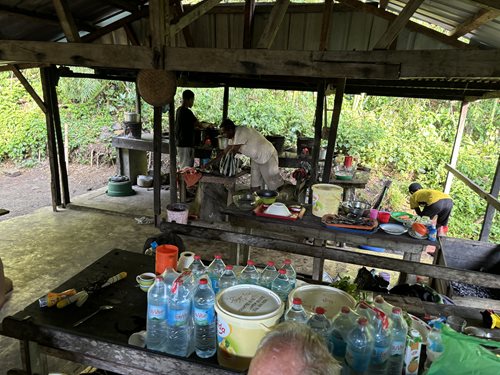 |
| The kitchen area of Camp One, 'Mantella', at Marojejy |
Next morning we set off uphill again with Donation in the lead once more, still walking too slowly, sometimes on his phone, not pointing out any wildlife. I tried letting him walk ahead so I could settle to my own walking pace but he’d wait for me and then stay half a pace ahead patronisingly pointing to where I needed to place each foot on any little incline. I wasn’t exactly having a wilderness experience. But he did lose interest in me if I stopped to photograph a tree-frog or flower or gecko.
From where we’d started out that day, Camp Two was only another couple of kilometres as the vanga flies but it felt further, indeed according to Strava we walked twice that distance. And we needed to ascend 300 vertical metres. The path zigzagged and switched back and we often wandered off piste to admire wildlife. Then, as one of our porters overtook us, he pointed into the scrubby forest and said,
‘Oiseau!’
We peered and finally my eyes caught an odd oval of sky-blue with a big beady eye at one end. There, calmly sitting on this nest, was the incredibly rare Helmet Vanga, representing an entire family of birds that are only found in Madagascar.
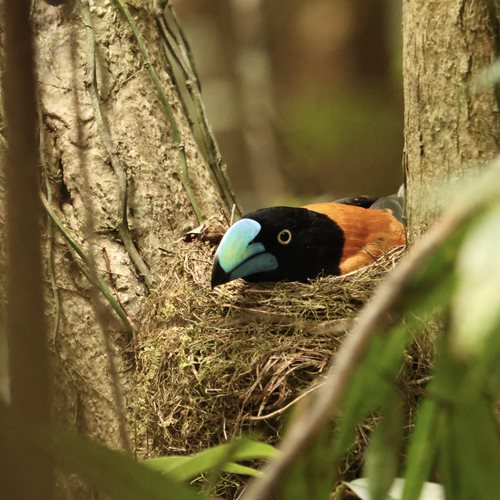 |
| An endemic Helmet Vanga incubating his eggs - photo by Simon Howarth |
By the time we reached Marojejya Camp we’d seen so much, and now we were in the forest home of the rarest lemur, the
simpona or Silky Sifaka.
Our guides had employed two trackers or spotters who they called
pisseurs (which seemed a bit rude) who had been up since dawn searching for Sifaka for us. So once we’d arrived in the upper camp and glugged now a bellyful of water, we headed on up and steeply up a further 150m or so of altitude to join our trusty
pisseurs. The trackless terrain was fearfully steep, the ground loose, the leaf litter deep and we needed to duck under or around creepers and scrub, dislodging rocks while our guides shouted directions. Our approach was clumsy and very noisy but finally we reached a spot where we could see across a steep gully to where several Silky Sifaka sat in the treetops munching and swallowing down carefully selected leaves. They are relatively big for lemurs, weighing five or six kilogrammes, and their luxuriant fur makes them seem even bigger. Upright and haughty, they peered across at us and at first seemed unphased but something spooked them and several shouted their
shiff-fack alarm call, shouting their name that sounds like an obscenity. They leapt elegantly away, their snow-white fur streaming out behind, the sound of swishing branches becoming ever quieter as they moved further from us. It transpired that this little troop was well known; they must have achieved celebrity status. Donation told us that they were a couple with two young males. There had been a fifth – another youngster – but it had fallen and died that spring.
Excitement at having glimpsed this beautiful species whose world population may total only 250 individuals moved on to concern. Locals clearly understood that their income from eco-tourists depends upon the survival of the Silky Sifaka but was everyone in the region equally interested in their survival? We returned to camp, demolishing more of the mountainside as we descended, elated at the sighting feeling so privileged to have experienced this encounter, and over dinner Donation told us that the
pisseurs would go out again at dawn next morning and we’d have a chance to get closer better views. He also said that anyone who wanted to could summit the mountain although that too would require a very early start. The terrain higher up looked increasingly barren and we decided that lemur-watching appealed more than conquering the mountain, even a mountain as spectacular as this.
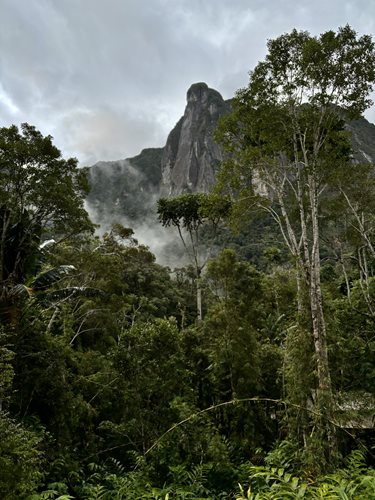 |
| The Marojejy Massif at 2132m is one of the highest points on Madagascar |
The next day we were scrambling about again above Camp Two trying to home in the
pisseurs shouts. The terrain seemed even more steep and treacherous than it had the previous day and I felt thankful that the plants at this altitude were less spiky and thorny, and nothing stung me. But it was still hard making progress through the dense undergrowth, climbing over fallen trees fighting though liana-spaghetti, negotiating rotten logs and large boulders. Then we were able to achieve positions where we could see the celebrity troop well, and once again they seemed pretty calm, munching hungrily with only the occasional glance to check us out. The ground was so steep though, it was challenging to find a spot to stand with both feet secure at the same level and have the best view of the Sifaka. I searched in vain for somewhere to sit, or even a tree to lean against for a steady shot with my camera. Leaves obscured them or they’d be silhouetted against the sky, or they’d turn away or move to be better branch at just the wrong moment. I thought of the patience of real wildlife photographers and cinematographers, and happily surrendered to the moment, settling down to merely watch and enjoy.
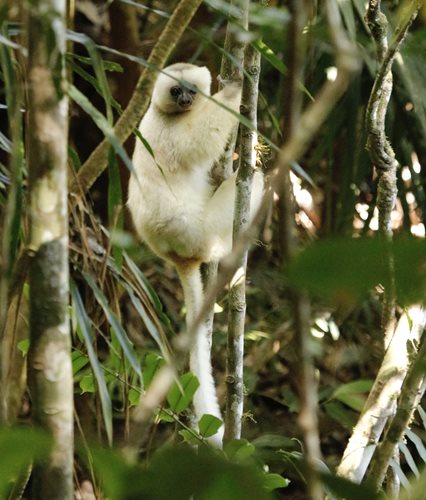 |
| The folivorous Silky Sifaka or simpona; WWF says only 250 survive globally |
We were all thoroughly satisfied by the time we’d spent a couple of hours with the lemurs and headed back to camp and lunch. The walless dining area was perched against the mountainside partly on stilts so well set up for us to look out across the forest and enjoy watching drongos dive-bombing insects and sunbirds with metallic blue feathers sipping nectar. And concrete steps leading up to the building were favourite sunning spots for lizards. Scampering sounds drew my attention to other visitors. A mother and youngster who alternately came to checkout anything brought for the diners or made raids into the kitchen area or the spot where vegetable peelings were thrown. These cheeky, pointy-nosed creatures were representatives of the weasel family with beautiful sleek red fur, and red and back striped tails. They were fast and sometimes we had to chase them off the tabletops.
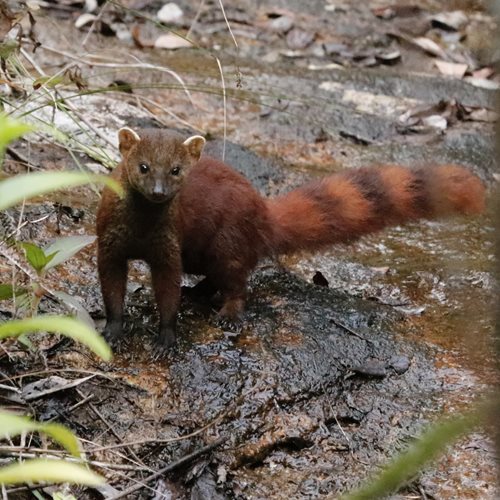 |
| A cheeky young Madagascar Ring-tailed Mongoose - a representative of one of only six mammal families that reached Madagascar |
Satiated after a good leisurely lunch, I was en route for the bathroom when there was a shout from one of the cooks alerting us to a visit by a large troop of red-bellied lemurs. Like all the lemurs at this altitude, their coats were long and cosy-looking; they too were a handsome chestnut reddish, and the males wore white facepaint. Later a troop of white-fronted brown lemurs passed through too. I wanted to stay here forever but our food - and more importantly coffee - supplies were dwindling suspiciously fast – faster than the supplies of other visitors – and suspected our local guide had a hand this. We weren’t exactly starving though and anyway the plan was to begin our descent the following day.
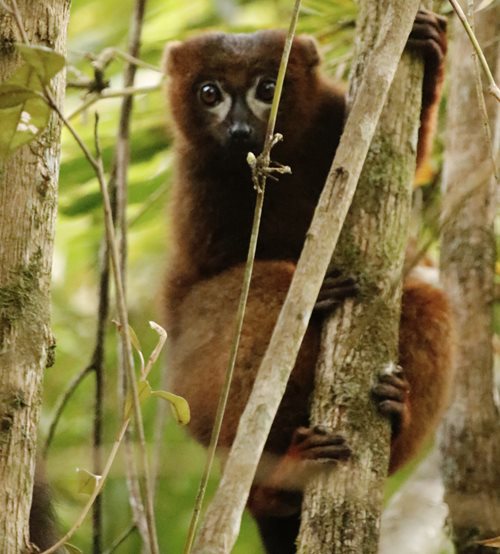 |
| Male Red-bellied Lemurs have striking white markings on their faces |
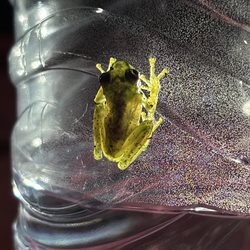 |
| Tree-frogs appeared at dinner time and sometimes hopped onto our water glasses |
There are more Madagascar blogs about other forest areas here
Return to Ankarana
Nosy Be to Nosy Hara
Deep emerald green